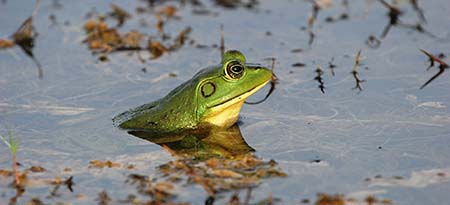
Pigfrog © John Cassani
Monitoring
Protocols
1.
Establishing a new route: Determine 12 monitoring locations or stops
at least 0.5 miles apart. Road intersections are typically used
for stop locations. Ten
of these locations or stops will become the permanent route with
the two remaining for backup if a location or stop has to be changed
in the future. Note: it is often difficult to hear frogs calling
when lots of traffic is present near the monitoring stop.
2.
Carefully describe the location of each stop and indicate its location
on a detailed road map. If possible indicate the GPS latitude and
longitude for each stop. Make several copies of the information
and mail the original to the network coordinator.
3.
If you are the route leader you will be responsible for recording
data (forms provided)
for each monitoring date. Please complete the data forms as completely
as possible. Route leaders are also responsible for coordinating
their route monitoring team. This involves calling team members
to remind them of monitoring dates and coordinating a place to meet
for car-pooling if necessary. The completed data forms should be
copied and the original immediately sent to the network coordinator.
4.
Check the newspaper for times of sunset and plan to arrive at the
first stop 30 minutes after sunset.
5.
When arriving at a stop, wait one minute before you start recording
information. After one minute begin recording frog species detected
for three minutes. Use your portable CD player to confirm the frog
calls that you hear if necessary. Finish recording the other information
such as temperature and wind speed required at each stop before
proceeding to the next stop.
6.
Of the ten stops that you monitor, start at a different stop (randomly
determined) for each date monitored.
Equipment
checklist: thermometer, digital stopwatch, portable CD player, frog
call CD, clipboard,
pencil (please do not use ink), data forms, flashlight, bug spray,
rain gear, first aid kit (optional), cell phone (optional).
|